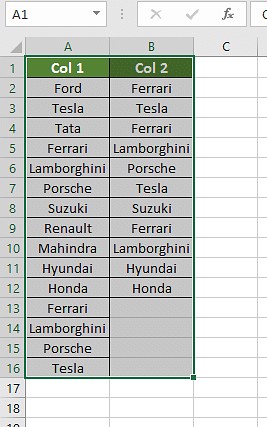In data analysis, comparing columns in Excel is a fundamental task. Whether you’re reconciling datasets, identifying discrepancies, or cleaning data, knowing how to compare columns efficiently is crucial. This process becomes even more powerful when you need to go beyond simple comparison and remove unique values, focusing instead on the commonalities between your datasets. Manually sifting through columns for differences and then isolating common entries can be incredibly time-consuming. Fortunately, Excel offers several built-in features and formulas to streamline this process, allowing you to compare columns and remove unique values in seconds.
Understanding Column Comparison and Unique Value Removal in Excel
Comparing columns in Excel involves checking corresponding cells across different columns to find matches or differences. Removing unique values takes this a step further. After comparing columns, you might want to identify and eliminate the entries that appear in only one of the columns, leaving you with only the values that are present in both. This is particularly useful when you need to find common entries between two lists, databases, or datasets.
Let’s explore various methods to achieve this effectively.
Methods to Compare Columns in Excel and Remove Unique Values
Here are several effective techniques to compare two columns in Excel and then remove the unique values, focusing on different Excel functionalities:
- Conditional Formatting to Highlight Common Values
- Using COUNTIF to Identify and Filter Unique Values
- Combining Filters with Comparison Formulas for Removal
- Advanced Filter for Extracting Common Records
- Leveraging Power Query for Robust Comparison and Filtering
Using Conditional Formatting to Highlight Common Values
Conditional Formatting is a visually intuitive way to start comparing columns. While it doesn’t directly remove values, it helps you quickly identify common entries, which is the first step towards isolating and removing unique values.
Step 1: Select Your Comparison Range
Select the two columns you want to compare. For example, if your data is in columns A and B, select the range containing your data in both columns.
Step 2: Apply Conditional Formatting for Duplicates
Navigate to the “Home” tab on the Excel ribbon, and in the “Styles” group, click on “Conditional Formatting.” From the dropdown menu, choose “Highlight Cells Rules,” and then select “Duplicate Values.”
Step 3: Customize Formatting for Common Values
In the “Duplicate Values” dialog box, ensure that “Duplicate” is selected in the dropdown menu. Choose your desired formatting style to highlight the common values. You can select from preset styles or create a custom format. Click “OK.”
Now, Excel will highlight the values that appear in both selected columns, visually representing the common entries. While this doesn’t remove unique values, it’s a crucial visual step in identifying them and preparing for removal.
Utilizing the COUNTIF Function to Identify Unique Values for Removal
The COUNTIF function is a powerful tool to count how many times a specific value appears within a range. We can use this to identify unique values (those that appear only once across both columns) and then filter them out.
Step 1: Create a Helper Column
Insert a new column next to your data (e.g., Column C if you are comparing Columns A and B). This will be your helper column to calculate counts.
Step 2: Apply the COUNTIF Formula
In the first cell of your helper column (e.g., C1), enter the following formula and drag it down for all rows:
=COUNTIF($A:$B,A1)Explanation of the formula:
COUNTIF($A:$B,A1): This formula counts how many times the value in cellA1appears within the entire range of columns A and B ($A:$B). The$signs ensure that the column range remains fixed when you drag the formula down.A1will adjust toA2,A3, etc., as you drag down, checking each value in column A.
Step 3: Filter for Values Not Present in Both Columns (Unique Values)
After applying the formula, column C will show the count of each value from column A across both columns A and B. Values that are unique (present in only one column) will have a count of 1 (or potentially just in column A and not B, depending on your data). Values present in both will have a count greater than 1.
To remove unique values, we need to filter for counts greater than 1.
- Select the entire data range including your helper column and headers.
- Go to the “Data” tab on the ribbon and click “Filter.”
- Click the dropdown arrow in the header of your helper column (Column C).
- Uncheck “1” (or any other count representing values you consider unique based on your definition).
- Click “OK.”
This will filter your data to show only the rows where the values in column A are also present in column B (and vice versa if you adjusted the formula). You can now copy this filtered data to a new sheet if you want to permanently remove the unique values from your original dataset.
Combining Filters with Comparison Formulas for Removal
For more customized comparison and removal, you can combine Excel’s filtering capabilities with direct comparison formulas using the equals operator (=) or the IF formula.
Step 1: Use the Equals Operator for Direct Comparison
In a helper column (e.g., Column C), use the equals operator to compare corresponding cells in columns A and B:
=A1=B1Drag this formula down. It will return “TRUE” if the values in A1 and B1 are the same, and “FALSE” otherwise.
Step 2: Use the IF Formula for Custom Output
Alternatively, use the IF formula for more descriptive results in your helper column:
=IF(A1=B1,"Match","Unique")This formula will display “Match” if A1 and B1 are the same, and “Unique” if they are different.
Step 3: Filter to Remove “Unique” Values
- Apply filters to your data range (including the helper column) from the “Data” tab.
- In the filter dropdown of your helper column, uncheck “FALSE” (if using the equals operator) or “Unique” (if using the IF formula).
- Click “OK.”
This will filter your data to show only the rows where the values in column A and column B are the same, effectively showing the common values and hiding the unique ones.
Employing Advanced Filter for Removing Unique Values
Excel’s Advanced Filter provides more sophisticated filtering options, including the ability to extract unique records or filter in place based on complex criteria. While “Advanced Filter” is often used to find unique rows, we can adapt it to help identify and remove unique values in column comparisons. For removing truly unique values between two columns, the previous COUNTIF method is generally more direct. However, if you need to find rows where values are unique within a column relative to another column, Advanced Filter could be part of a more complex approach. For simple unique value removal between two columns, COUNTIF and basic filtering are more streamlined.
Leveraging Power Query for Robust Comparison and Filtering
Power Query is Excel’s powerful data transformation and manipulation tool. It offers a robust and flexible way to compare columns and remove unique values, especially when dealing with larger datasets or more complex comparison scenarios.
Step 1: Load Your Data into Power Query
- Select your data range in Excel.
- Go to the “Data” tab and click “From Table/Range” in the “Get & Transform Data” group. This will load your data into the Power Query Editor.
Step 2: Merge Queries to Find Common Values (Inner Join)
To find common values, you can use Power Query’s “Merge Queries” feature with an “Inner Join.”
- In the Power Query Editor, if your two columns are in the same table, you might need to duplicate the query to treat them as separate entities for merging. If they are already in separate tables (or queries), proceed.
- Select one of your queries.
- Go to “Home” tab, click “Merge Queries” and select “Merge Queries as New” (or “Merge Queries” to modify the existing query).
- In the “Merge” dialog box:
- Choose your primary table (query) from the top dropdown.
- Select the column you want to compare from this table.
- Choose your second table (query) from the bottom dropdown.
- Select the corresponding column to compare from the second table.
- For “Join Kind,” choose “Inner (only matching rows).” This is crucial for finding common values.
- Click “OK.”
Step 3: Expand the Merged Table and Remove Unnecessary Columns
Power Query will create a new query with the merged results. It will initially include a new column containing a table.
- Click the “Expand” button (two opposing arrows) on the header of the new table column.
- Uncheck “Select All” and choose only the columns you need from the merged table (typically the columns containing the common values and any other relevant data). Uncheck “Use original column name as prefix” if you don’t want prefixes.
- Click “OK.”
Now, your Power Query result will contain only the rows where the values in the compared columns were found in both original datasets. You’ve effectively removed the unique values and kept only the common ones.
Step 4: Load the Result Back to Excel
- Go to “Home” tab in Power Query Editor.
- Click “Close & Load” or “Close & Load To…” to load the transformed data back into an Excel sheet.
Power Query offers a more structured and repeatable way to handle column comparisons and unique value removal, especially beneficial for complex data manipulations and automation.
Best Practices for Column Comparison and Unique Value Removal
- Understand Your Data: Before comparing, ensure you understand the data types and formats in your columns. Inconsistent formatting can lead to inaccurate comparisons.
- Choose the Right Method: Select the method that best suits your data size, complexity of comparison, and desired outcome (visual identification, filtering, permanent removal).
- Helper Columns: Using helper columns for formulas like
COUNTIFor direct comparisons keeps your original data intact and makes the process easier to follow and audit. - Power Query for Complex Tasks: For larger datasets, complex transformations, or repeatable processes, Power Query offers a more robust and efficient solution.
- Verify Results: After applying any method, always verify your results to ensure accuracy, especially when removing data.
Conclusion
Comparing columns in Excel and removing unique values is a vital skill for data analysis and data cleaning. Whether you use Conditional Formatting for visual cues, formulas like COUNTIF and IF for filtering, or Power Query for advanced transformations, Excel provides a range of tools to effectively manage and compare your data. By mastering these techniques, you can significantly enhance your data analysis workflow and derive meaningful insights from your spreadsheets.
By focusing on removing unique values after comparison, you refine your datasets to highlight commonalities, identify intersections, and clean your data for more accurate and focused analysis. Excel’s versatile features empower you to handle these tasks efficiently and effectively.


